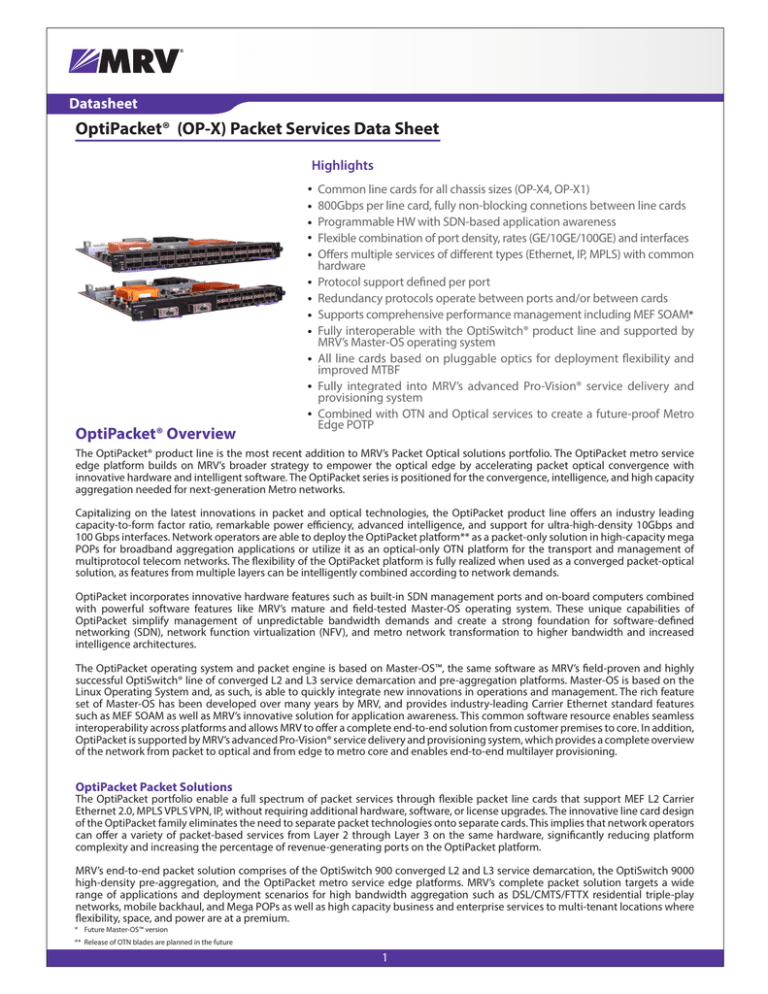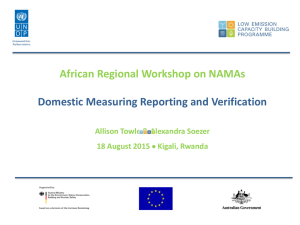
Datasheet
OptiPacket® (OP-X) Packet Services Data Sheet
Highlights
OptiPacket® Overview
Common line cards for all chassis sizes (OP-X4, OP-X1)
800Gbps per line card, fully non-blocking connetions between line cards
Programmable HW with SDN-based application awareness
Flexible combination of port density, rates (GE/10GE/100GE) and interfaces
Offers multiple services of different types (Ethernet, IP, MPLS) with common
hardware
Protocol support defined per port
Redundancy protocols operate between ports and/or between cards
Supports comprehensive performance management including MEF SOAM*
Fully interoperable with the OptiSwitch® product line and supported by
MRV’s Master-OS operating system
All line cards based on pluggable optics for deployment flexibility and
improved MTBF
Fully integrated into MRV’s advanced Pro-Vision® service delivery and
provisioning system
Combined with OTN and Optical services to create a future-proof Metro
Edge POTP
The OptiPacket® product line is the most recent addition to MRV’s Packet Optical solutions portfolio. The OptiPacket metro service
edge platform builds on MRV’s broader strategy to empower the optical edge by accelerating packet optical convergence with
innovative hardware and intelligent software. The OptiPacket series is positioned for the convergence, intelligence, and high capacity
aggregation needed for next-generation Metro networks.
Capitalizing on the latest innovations in packet and optical technologies, the OptiPacket product line offers an industry leading
capacity-to-form factor ratio, remarkable power efficiency, advanced intelligence, and support for ultra-high-density 10Gbps and
100 Gbps interfaces. Network operators are able to deploy the OptiPacket platform** as a packet-only solution in high-capacity mega
POPs for broadband aggregation applications or utilize it as an optical-only OTN platform for the transport and management of
multiprotocol telecom networks. The flexibility of the OptiPacket platform is fully realized when used as a converged packet-optical
solution, as features from multiple layers can be intelligently combined according to network demands.
OptiPacket incorporates innovative hardware features such as built-in SDN management ports and on-board computers combined
with powerful software features like MRV’s mature and field-tested Master-OS operating system. These unique capabilities of
OptiPacket simplify management of unpredictable bandwidth demands and create a strong foundation for software-defined
networking (SDN), network function virtualization (NFV), and metro network transformation to higher bandwidth and increased
intelligence architectures.
The OptiPacket operating system and packet engine is based on Master-OS™, the same software as MRV’s field-proven and highly
successful OptiSwitch® line of converged L2 and L3 service demarcation and pre-aggregation platforms. Master-OS is based on the
Linux Operating System and, as such, is able to quickly integrate new innovations in operations and management. The rich feature
set of Master-OS has been developed over many years by MRV, and provides industry-leading Carrier Ethernet standard features
such as MEF SOAM as well as MRV’s innovative solution for application awareness. This common software resource enables seamless
interoperability across platforms and allows MRV to offer a complete end-to-end solution from customer premises to core. In addition,
OptiPacket is supported by MRV’s advanced Pro-Vision® service delivery and provisioning system, which provides a complete overview
of the network from packet to optical and from edge to metro core and enables end-to-end multilayer provisioning.
OptiPacket Packet Solutions
The OptiPacket portfolio enable a full spectrum of packet services through flexible packet line cards that support MEF L2 Carrier
Ethernet 2.0, MPLS VPLS VPN, IP, without requiring additional hardware, software, or license upgrades. The innovative line card design
of the OptiPacket family eliminates the need to separate packet technologies onto separate cards. This implies that network operators
can offer a variety of packet-based services from Layer 2 through Layer 3 on the same hardware, significantly reducing platform
complexity and increasing the percentage of revenue-generating ports on the OptiPacket platform.
MRV’s end-to-end packet solution comprises of the OptiSwitch 900 converged L2 and L3 service demarcation, the OptiSwitch 9000
high-density pre-aggregation, and the OptiPacket metro service edge platforms. MRV’s complete packet solution targets a wide
range of applications and deployment scenarios for high bandwidth aggregation such as DSL/CMTS/FTTX residential triple-play
networks, mobile backhaul, and Mega POPs as well as high capacity business and enterprise services to multi-tenant locations where
flexibility, space, and power are at a premium.
* Future Master-OS™ version
** Release of OTN blades are planned in the future
1
Datasheet
MRV’s End-to-end Packet solution with OptiSwitch®, OptiPacket® and Pro-Vision®
The Packet line cards offer Carrier Ethernet E-line and E-LAN services either via native Layer 2 or via MPLS/VPLS technologies.
In addition, the Packet cards will support a variety of Layer 3 services including Direct Internet Access (DIA), IP-Multicast,
and MPLS Layer 3 VPNs.
OptiPacket’s Packet line cards offer comprehensive and multi-layer OAM tools with SLA monitoring and assurance.
The OptiPacket’s Packet line cards support a wide range of port capacity, data rate, and interfaces as described in the table below:
Packet Line Card
Line Card
40 x 10GE
20 x 10GE + 20 x 1GE
2 x 100GE + 20 x 10E
8 x 10GE SFP+ and 64 x 1GE
Interfaces
40 SFP+ ports. Optical and electrical pluggables supported
SFP+ ports. Optical and electrical pluggables supported
2 x CFP2 ports, 20 x SFP+ ports
CSFP ports. Also supports SFP (1 x GE) optics
Table 1 - OptiPacket’s Packet Line Card Portfolio (not all line cards may be available in the current release)
Technical Specifications
Switching capacity
L2 and MPLS VPLS VPN support
800 Gb per line card, fully non-blocking connections between line cards
• L2
• VPLS / H-VPLS
• MPLS Psuedowires
Protection schemes
• ERPS G.8032 and ELPS G.8031*
• FRR (RFC 4090) in the VPLS cloud
• Dual home VC in the VPLS cloud
• LAG per 802.1AX and MC-LAG*
QoS
• Per port QoS and per service (VPLS, VLAN) QoS mechanisms
• H-QoS based on concatenation of policing and metering and MEF 10.3*
• Ingress and Egress shaping per service*
• Rate limiting per port, per service* (VLAN, VPLS), and per flow*
• Strict priority and WRR scheduling
• WRED and Tail-drop congestion avoidance mechanisms
• QoS Counters: per flow policers: per drop precedence, per flow, per service
OAM
• L2 CE 2.0
- MEF 35 SOAM-PM*: 5 KPIs (Delay, Jitter, FL per ITU.T Y.1731) Service Availability
and Service Resiliency per ITU.T Y.1563 and MEF 10.2.1
- Connectivity Check Messages per IEEE 802.1ag
- Fault-Monitoring: RDI (Remote Defect Indication), AIS (Alarm Indication Signal)
• MPLS/IP
- MPLS OAM per RFC 4379
- MPLS BFD per RFC 5884
- MPLS VCCV per RFC 5085
Network management and service provisioning Supported by MRV’s advanced Pro-Vision® service delivery and provisioning system
* Future Master-OS™ version
MRV operates Worldwide sales and service offices across four continents.
Contact us at info@mrv.com
http://www.mrv.com
All statements, technical information and recommendations related to the products herein are based upon information believed to be reliable or accurate. However, the
accuracy or completeness thereof is not guaranteed, and no responsibility is assumed for any inaccuracies. Please contact MRV Communications for more information.
MRV Communications and the MRV Communications logo are trademarks of MRV Communications, Inc. Other trademarks are the property of their respective holders.
MRV-OP-X-Packet Services-021915 Rev. A2
Copyright ©2015 MRV Communications, Inc. All Rights Reserved.




